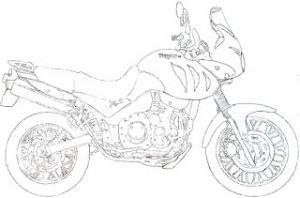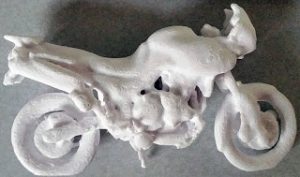 What I’ve got here is a photo of my Triumph Tiger 955i taken as near to fully side on as I could manage it. I then photoshoped into a outline (trace contour and some negative inversion along with some line cleanup did it). I saved that image as a vector and shared it with my trusty technology design teacher at work. She cleaned up the lines a bit (mainly simplifying them) so they could be cut into perspex using a computer controlled router.
What I’ve got here is a photo of my Triumph Tiger 955i taken as near to fully side on as I could manage it. I then photoshoped into a outline (trace contour and some negative inversion along with some line cleanup did it). I saved that image as a vector and shared it with my trusty technology design teacher at work. She cleaned up the lines a bit (mainly simplifying them) so they could be cut into perspex using a computer controlled router.
With a bit of coding you could colour code the display to something specific or make different patterns. The strip along the bottom is 9 leds long, so you could get pretty fancy with patterns if that floated your boat. I’ve also seen Arduinos run like graphic equalizers, responding to music with different colours and patterns, so that’s another option.
Metres long LED strips can be gotten cheap. An Arduino can be had for less than $10 if you’re cagey about it. Three wires and a bit of perspex and you’re ready to go. I’d guess in raw parts it cost all of about ten bucks to put together, and that includes an Arduino that could do a lot of other things. If you’ve got a customized bike, a clean photo and a bit of prep and you’d have a disco light version of your specific machine.
I 3d modelled the Tiger a while ago using a Structure Sensor. It snaps on to an ipad and is very straightforward to use. Once you’ve ‘painted’ in your 3d model using the lasers on the sensor you can clean it up in something like the 3d modelling software that is included in Windows 10. Here is what an upload of that looks like on Sketchfab:
Like the disco light above, what’s nice about this is that it’s a direct copy of my specific bike. If you’ve got a custom ride, scanning it with the Structure Sensor and then printing it out on something nice like the Formlabs printer would mean a smooth, accurate scale model of your particular machine.
from Blogger http://ift.tt/2rr7am6
via IFTTT

